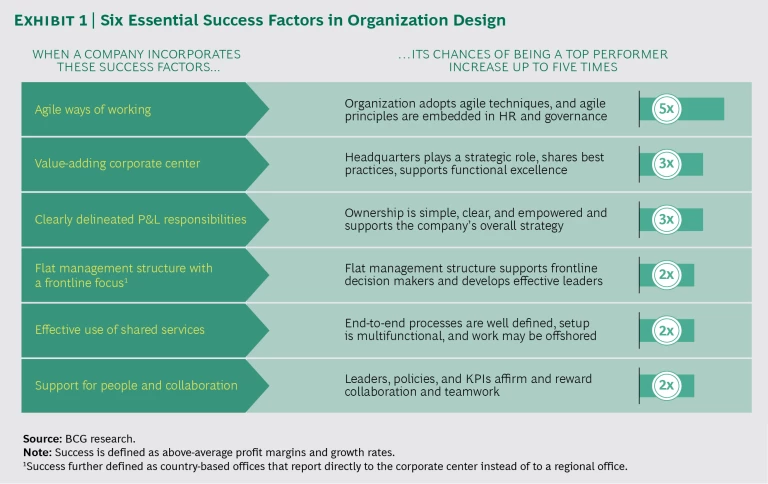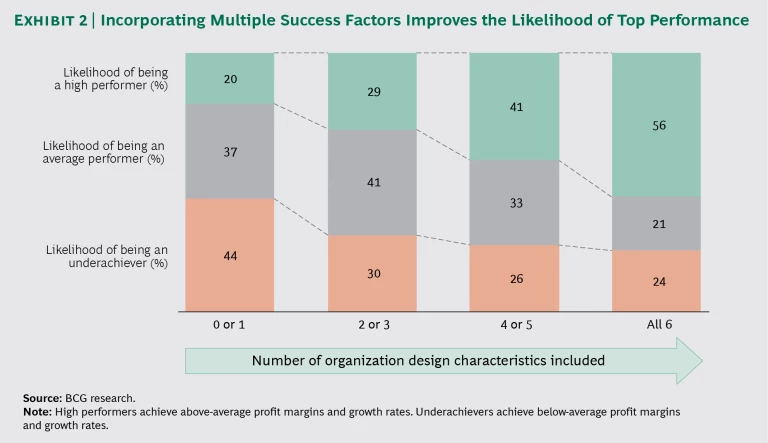Companies of all sizes are grappling with accelerating challenges brought on by shifting economic pressures, market conditions, and customer preferences, as well as by technological innovation. In response, many are changing the design of their organizations in order to make them more flexible, enable them to offer new services, and unlock the value hidden in existing operations and thereby boost financial performance.
But change for its own sake isn’t enough. In a BCG survey, two-thirds of respondents told us that their enterprises had reorganized recently, but only half deemed the effort mostly or very successful. Analysis of the same survey results suggests that six specific factors in organization design can make a company more likely to become a top performer, with faster growth and higher profits than its peers. The six factors are:
- Agile ways of working
- A value-adding corporate center
- Clearly delineated profit and loss (P&L) responsibilities
- A flat management structure with a strong frontline focus
- Effective use of shared services
- Strong support for people and collaboration
Agile ways of working is the most critical of these factors. Agile companies are up to five times more likely than their peers to become top performers. They are also more likely to include the other elements, which is significant because a company that incorporates all six will benefit from a multiplier effect: its chance of becoming a top performer increases to more than 50%.
Reorganizing for Flexibility
We undertook our survey in order to understand the elements of organization design that unlock value, thereby making companies more successful. (See "Methodology") The surveyed companies were organized by product (29%), region (22%), function (21%), customer (15%), and other criteria (13%). Within each category were top performers that are growing quickly and have above-average margins, average performers, and underperformers that trail their competitors.
Methodology
In the fourth quarter of 2016, BCG surveyed approximately 1,100 executives and other employees at companies with more than 1,000 employees, representing ten industries in more than 40 countries. The survey was conducted online in collaboration with Gesellschaft für Organisation (Society for Organization), Österreichische Vereinigung für Organisation und Management (Austrian Association for Organization and Management), Schweizerische Gesellschaft für Organisation und Management (Swiss Society for Organization and Management), and the Japan Management Association. It included questions about each company’s industry as well as about the company’s size, financial performance, organization design, and how many of the six factors were incorporated into the design. In the survey results, top performers were defined as growing faster and maintaining higher profit margins than their competitors. To make the data comparable, results were weighted to compare equal numbers of successful and unsuccessful companies and the data normalized accordingly. Since every organization is unique, results are offered for guidance only.
Our study confirmed the common wisdom that a company’s success does not depend on any specific organizational model, which is determined primarily by the enterprise’s underlying strategy. Rather, the difference between organization designs that work and those that don’t lies in the presence or absence of the six factors listed above. (See Exhibit 1.) Organizations that incorporate those ingredients of design are likelier than their peers to be flexible and ready to respond to changing business conditions.
Companies that want to take advantage of the six factors so critical to success should evaluate their current position and design a tailored program to overcome the identified shortfalls. Such a review is in keeping with the changes many organizations are considering in response to the forces revolutionizing the way work gets done. (BCG is examining those forces in its New New Way of Working Series. See Twelve Forces That Will Radically Change How Organizations Work, BCG Focus, March 2017. Also see Organization of the Future—Designed to Win: Flipping the Odds for Successful Reorganization, BCG Focus, April 2012.)
We should note that three of these factors—a value-adding corporate center, clearly delineated P&L responsibilities, and effective shared services—are considered classic elements of good organization design. Agile ways of working and support and collaboration are much newer concepts. Flat organizations that focus on frontline operations partake of some of the classic elements of successful organization design as well as some newer traits.
Below we take a more in-depth look at these critical ingredients of organization design.
Agile Ways of Working
Companies use these business methods to respond more quickly to changes in customer demand or market opportunities. Agile ways of working help save time, simplify decision making, and engage and empower individual employees and teams. (See “Five Secrets to Scaling Up Agile,” BCG article, February 2016.)
Agile ways of working also enable the other five factors. In our survey, more than half the companies that had adopted agile ways of working also manage corporate functions efficiently, have clearly delineated P&L responsibilities, develop flat organizations that focus on frontline operations, make better use of shared services, and foster collaboration.
However, it is easier to appreciate the benefits of agile ways of working than to put the concept into practice. While 73% of survey respondents agreed that agility is important, only half said that their companies have adopted agile management and principles.
Most companies believe that agile ways of working are important in responding to changing customer needs, reducing time to market, creating value, and gaining a better return on their investments. Top performers also believe that such practices increase transparency throughout the organization and improve effectiveness by removing siloed business functions and minimizing the handoffs that can create bottlenecks. Finally, agility enhances employee engagement and helps attract and retain talent.
Truly agile companies take a holistic approach. They may start by adopting common agile practices, such as scrum teams, sprints, standup meetings, and agile software delivery. But they don’t stop there. Rather, they build agility into the whole organization. For example, they may create agile leadership models in which line managers become coaches and teams have sufficient autonomy to reach set targets. Or they may hardwire agility into HR processes, such as by establishing an agile talent platform and making sure agility-related KPIs are incorporated into performance management practices.
A Value-Adding Corporate Center
Headquarter functions are often seen as a burden, but companies with an effective corporate center are three times as likely to be top performers as their peers.
The precise role of the center and its specific value-adding activities may vary according to the organization’s underlying strategy. (See Designing the Corporate Center: How to Turn Strategy into Structure, BCG Focus, May 2013.) But a general pattern can be observed across organizations. The traditional responsibilities of the corporate center include allocating external and internal funds and overseeing strategy development. At top-performing companies, however, the corporate center also provides functional expertise, creates and promotes standards and best practices, identifies opportunities for business units to work together, and ensures that employee performance reviews line up with company goals. It also provides a reasonable level of operational engagement to improve business performance.
Despite the advantages that a value-adding corporate center offers, only 60% of respondents said that their headquarters function adds value to their business. Corporate centers add the most value in strategy development (according to 64% of respondents), functional excellence improvements (62%), performance management (62%), business synergies (60%), operational engagement (58%), and funding allocation (53%).
The most effective corporate centers improve their company’s performance through specific organization design decisions, such as those intended to avoid multiple reporting lines in support functions and set clear KPIs. They also build platforms and communities for sharing best practices and develop a strong talent pool to improve the quality of employees in headquarter functions.
Clearly Delineated P&L Responsibilities
Companies with clearly delineated P&L responsibilities are three times more likely to have faster growth and higher profits than their competitors.
Top performers clarify P&L responsibility in two ways. First, they ensure that it matches the company’s overall strategy and can be implemented in accordance with that strategy. For example, if a company’s operations are divided by geography, then P&L responsibility should be structured the same way. Second, they make sure that the leaders who bear the responsibility are empowered to influence results, including for the top-line and underlying cost structures.
Our research found that another way companies can make the responsibility for P&L clearer is by tying it to the corresponding business unit and rather than to the corporate center.
A Flat Management Structure with a Strong Frontline Focus
Companies that minimize the operational distance between the corporate center and customer-facing, or frontline, business units are twice as likely as their peers to become top performers.
A company can do this by reducing management layers, thus improving its understanding of local markets and support for customer-facing operations. A flatter management structure also results in greater cost effectiveness, enhances communication between the center and the frontline, and expands managers’ accountability. Another way to reduce the distance between the center and the frontline is to eliminate a management tier by linking country-based operations directly to the corporate center rather than to regional offices.
Today’s organizations are not there yet: almost 40% do not support frontline operations effectively, which hinders their ability to react quickly to changing market needs. By contrast, delayered organizations maintain a close connection between the center and the frontline and have expanded spans of control. As a result, decision makers can better anticipate developments and act on them earlier.
Effective Use of Shared Services
Companies able to move transaction-heavy administrative functions from individual business units to centralized shared services are more than twice as likely as their competitors to become top performers.
Seventy-four percent of our respondents outsource shared-service operations from divisions or business units to dedicated centers. They use shared-service centers for IT (68% of respondents), finance and accounting (58%), human resources (52%), procurement (38%), legal services (32%), communication and marketing (29%), and real estate services (26%). Sixty percent of those that use shared services run them as individual entities, while 40% move multiple services to cross-functional shared-service centers. Companies rarely make use of low-cost options: more than 50% of respondents said their company has a quarter or less of its shared-services resources in offshore locations; only 8% have three-quarters or more of their shared services offshore.
Shared services are not guaranteed to make a company more efficient. Although nearly 75% of respondents use shared-service centers, only half believe that they add value. Multiple challenges can hamper effectiveness, including inadequately defined processes and poor implementation. Other problems can stem from the lack of a clear understanding of who owns the process and failure to meet the needs of business unit clients.
Professional management can help companies make better use of transactional and other types of shared services. But getting there can take time. It often involves transforming the service center from a purely transactional-service operation for a dedicated function to an efficient full-service provider. Effective professional management can require decisions about structural design, such as the introduction of a multifunctional shared-service center that provides several functions under one roof, and about offshoring. Making the most of shared-service centers also requires integrated IT solutions, end-to-end processes with dedicated process owners, strong governance mechanisms, and performance management that rewards proper delivery and a strong focus on service and customers.
Support for People and Collaboration
Organizations with a collaborative, people-focused culture double their chance of being top performers. Nevertheless, about 40% of our respondents said that their company’s day-to-day efforts to support people and collaboration are deficient in some way.
Organizations can take meaningful steps to hardwire a trust-filled, collaborative environment into their operations. Top-performing companies give individuals clearly defined responsibilities, both for their own jobs and for work that they do in teams. In addition, top-performing companies use simple decision-making processes, reward collaboration, and make sure meetings have clear objectives. Finally, leaders at top performers are committed to collaboration and employee engagement, and they include policies and KPIs that support these principles in performance management goals and corresponding HR practices.
Incorporating the Six Factors
While organization design must be tailored to an individual company’s needs, enterprises that incorporate at least one of the six ingredients described above are likely to see above-average growth and profits. And companies that incorporate all six increase the likelihood of a becoming top performer to more than 50%. (They do this, in part, by reducing the overall complicatedness that can impede financial performance. For more on this topic, see Mastering Complexity Through Simplification: Four Steps to Creating Competitive Advantage, BCG Focus, February 2017.) By contrast, companies that incorporate just one of the six ingredients have only a 20% chance of becoming a top performer—and a 44% chance of underachieving. (See Exhibit 2.)
Some company leaders will need to be convinced that their current organization design is not working. In our survey, for example, 82% of executives and 72% of top managers said their company is already focused on frontline operations, but only 40% of frontline employees felt that way.
To help bring top executives around, companies should analyze those aspects of their organization design that may be falling short and then prioritize areas for improvement. This can be accomplished by conducting a systematic survey of the existing design based on reliable benchmark data and using the results as the foundation for an upgrade plan. Once a plan for improvement has been mapped out, determine which areas to work on first and design a pilot project to test the concept and see how well it works before rolling out more comprehensive changes.
The new realities of business make it important for companies to adopt organization designs that can help them respond quickly to changing market conditions, roll out new services, and find value that was previously hidden in existing operations. The best way to do that is to address the six factors that play such a large role in increasing a company’s chances of becoming a top performer.








